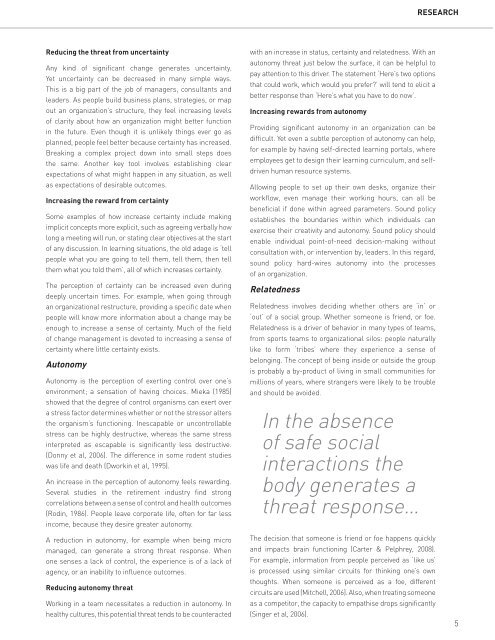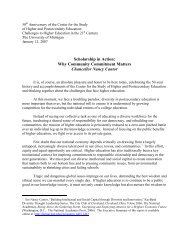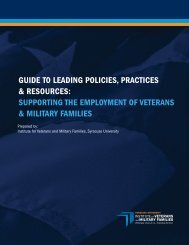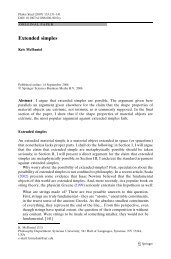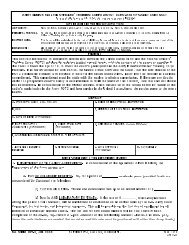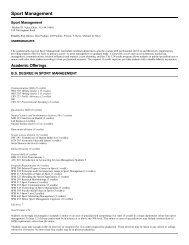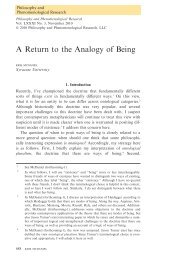esearchReducing the threat from uncertaintyAny kind of significant change generates uncertainty.Yet uncertainty can be decreased in many simple ways.This is a big part of the job of managers, consultants andleaders. As people build business plans, strategies, or mapout an organization’s structure, they feel increasing levelsof clarity about how an organization might better functionin the future. Even though it is unlikely things ever go asplanned, people feel better because certainty has increased.Breaking a complex project down into small steps doesthe same. Another key tool involves establishing clearexpectations of what might happen in any situation, as wellas expectations of desirable outcomes.Increasing the reward from certaintySome examples of how increase certainty include makingimplicit concepts more explicit, such as agreeing verbally howlong a meeting will run, or stating clear objectives at the startof any discussion. In learning situations, the old adage is ‘tellpeople what you are going to tell them, tell them, then tellthem what you told them’, all of which increases certainty.The perception of certainty can be increased even duringdeeply uncertain times. For example, when going throughan organizational restructure, providing a specific date whenpeople will know more information about a change may beenough to increase a sense of certainty. Much of the fieldof change management is devoted to increasing a sense ofcertainty where little certainty exists.AutonomyAutonomy is the perception of exerting control over one’senvironment; a sensation of having choices. Mieka (1985)showed that the degree of control organisms can exert overa stress factor determines whether or not the stressor altersthe organism’s functioning. Inescapable or uncontrollablestress can be highly destructive, whereas the same stressinterpreted as escapable is significantly less destructive.(Donny et al, 2006). The difference in some rodent studieswas life and death (Dworkin et al, 1995).An increase in the perception of autonomy feels rewarding.Several studies in the retirement industry find strongcorrelations between a sense of control and health outcomes(Rodin, 1986). People leave corporate life, often for far lessincome, because they desire greater autonomy.A reduction in autonomy, for example when being micromanaged, can generate a strong threat response. Whenone senses a lack of control, the experience is of a lack ofagency, or an inability to influence outcomes.Reducing autonomy threatWorking in a team necessitates a reduction in autonomy. Inhealthy cultures, this potential threat tends to be counteractedwith an increase in status, certainty and relatedness. With anautonomy threat just below the surface, it can be helpful topay attention to this driver. The statement ‘Here’s two optionsthat could work, which would you prefer?’ will tend to elicit abetter response than ‘Here’s what you have to do now’.Increasing rewards from autonomyProviding significant autonomy in an organization can bedifficult. Yet even a subtle perception of autonomy can help,for example by having self-directed learning portals, whereemployees get to design their learning curriculum, and selfdrivenhuman resource systems.Allowing people to set up their own desks, organize theirworkflow, even manage their working hours, can all bebeneficial if done within agreed parameters. Sound policyestablishes the boundaries within which individuals canexercise their creativity and autonomy. Sound policy shouldenable individual point-of-need decision-making withoutconsultation with, or intervention by, leaders. In this regard,sound policy hard-wires autonomy into the processesof an organization.RelatednessRelatedness involves deciding whether others are ‘in’ or‘out’ of a social group. Whether someone is friend, or foe.Relatedness is a driver of behavior in many types of teams,from sports teams to organizational silos: people naturallylike to form ‘tribes’ where they experience a sense ofbelonging. The concept of being inside or outside the groupis probably a by-product of living in small communities formillions of years, where strangers were likely to be troubleand should be avoided.In the absenceof safe socialinteractions thebody generates athreat response…The decision that someone is friend or foe happens quicklyand impacts brain functioning (Carter & Pelphrey, 2008).For example, information from people perceived as ‘like us’is processed using similar circuits for thinking one’s ownthoughts. When someone is perceived as a foe, differentcircuits are used (Mitchell, 2006). Also, when treating someoneas a competitor, the capacity to empathise drops significantly(Singer et al, 2006).5
NeuroLeadershipJOURNAL6Neuroscientist John Cacioppo talks about the need for safehuman contact being a primary driver, like the need for food(Cacioppo, 2008). In the absence of safe social interactionsthe body generates a threat response, also known as feelinglonely. However, meeting someone unknown tends togenerate an automatic threat response. This explains whyone feels better at a party knowing three people rather thanone. Alcohol helps to reduce this automatic social threatresponse, enabling strangers to communicate more easily,hence its use as a social lubricant the world over. In theabsence of alcohol, getting from foe to friend can be helpedby an oxytocin response, an experience of connecting with theother person. Oxytocin is a hormone produced naturally inthe brain, and higher levels of this substance are associatedwith greater affiliative behavior (Domes et al, 2007). Studieshave shown far greater collaboration when people are givena shot of oxytocin, through a nasal spray. (Kosfield, 2005).A handshake, swapping names and discussing somethingin common, be it just the weather, may increase feelingof closeness by causing the release of oxytocin (Zak et al,2005). The concept of relatedness is closely linked to trust.One trusts those who appear to be in your group, who onehas connected with, generating approach emotions. Andwhen someone does something untrustworthy, the usualresponse is to withdraw. The greater that people trustone another, the stronger the collaboration and the moreinformation that is shared.Reducing threats from lack of relatednessIncreasing globalization highlights the importance ofmanaging relatedness threats. Collaboration between peoplefrom different cultures, who are unlikely to meet in person,can be especially hard work. The automatic foe responsedoes not get diminished by social time together. This responsecan be mitigated by dedicating social time in other forms.For example, using video to have an informal meeting, orensuring that people forming teams share personal aspectsof themselves via stories, photos or even social-networkingsites. In any workplace it appears to pay off well to encouragesocial connections. A Gallup report showed that organizationsthat encourage ‘water cooler’ conversations increasedproductivity (Gallup, November 2008).Increasing the rewards from relatednessPositive social connections are a primary need; however,the automatic response to new social connections involvesa threat. To increase the reward response from relatedness,the key is to find ways to increase safe connections betweenpeople. Some examples include setting up clearly definedbuddy systems, mentoring or coaching programs, or smallaction learning groups. Small groups appear to be safer thanlarge groups. The Gallup organizations research on workplaceengagement showed that the statement ‘I have a best friendat work’ was central to engagement in their ‘Q12’ assessment(Gallup Organization). Perhaps even having one trustingrelationship can have a significant impact on relatedness.FairnessStudies by Golnaz Tabibnia and Matthew Lieberman at UCLAshowed that 50 cents generated more of a reward in thebrain than $10.00, when it was 50 cents out of a dollar, andthe $10 was out of $50 (Tabibnia & Lieberman, 2007). Thisstudy and a number of others illustrate that fair exchangesare intrinsically rewarding, independent of other factors. Theneed for fairness may be part of the explanation as to whypeople experience internal rewards for doing volunteer workto improve their community; it is a sense of decreasing theunfairness in the world.Unfair exchanges generate a strong threat response(Tabibnia & Lieberman, 2007). This sometimes includesactivation of the insular, a part of the brain involved inintense emotions such as disgust. Unfair situations maydrive people to die to right perceived injustices, such as inpolitical struggles. People who perceive others as unfairdon’t feel empathy for their pain, and in some instances,will feel rewarded when unfair others are punished (Singeret al, 2006).Reducing the threat from unfairness and increasingthe reward from fairnessA threat response from a sense of unfairness can be triggeredeasily. The following statements are examples of whatemployees might say in reaction to a threat to fairness:• ‘He has a different set of rules for Mike and Sally than forthe rest of us.’• ‘Management tell us that we need to lose headcount, butour sales are carrying the other division and they don’thave to cut anyone.’• ‘They do all this talk about ‘values’ but it’s business asusual at the top.’The threat from perceived unfairness can be decreasedby increasing transparency, and increasing the level ofcommunication and involvement about business issues. Forexample, organizations that allow employees to know detailsabout financial processes may have an advantage here.Establishing clear expectations in all situations – from a onehourmeeting to a five-year contract – can also help ensurefair exchanges occur. A sense of unfairness can result froma lack of clear ground rules, expectations or objectives.Allowing teams to identify their own rules can also help. Inan educational context, a classroom that creates the rulesof what is accepted behavior is likely to experience lessconflict. Examples of the success of self-directed teams inmanufacturing abound (Semler, 1993). Much of what theseself-driven teams do is ensure fairness in grass-rootsdecisions, such as how workloads are shared and who cando which tasks.


